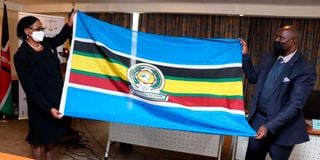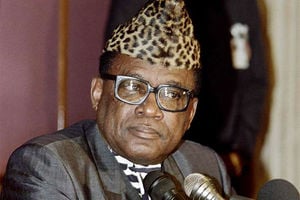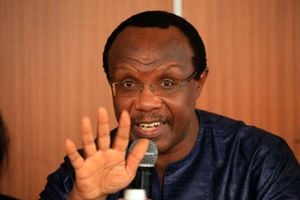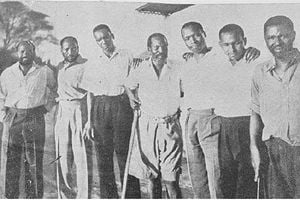
Chief Justice and President of Supreme Court Martha Koome receives and East Africa flag from the President of the East African Court of Justice Nestor Kayobera during a strategic plan validation meeting in Nairobi on July 21, 2021.
Along East Africa’s coast this week, there were two revealing contrasting stories about media. In Kenya, the government was sued by the Law Society of Kenya (LSK) for giving The Star newspaper the monopoly to publish and distribute state advertisements through a weekly supplement.
The LSK claims the move, which cuts out larger papers like The Standard, Daily Nation and People Daily, will stifle media freedom and limit public access to information in contravention of the Constitution.
Kenya has been considered the most free media market in East Africa for the past 25 years. To the south, Tanzania less so, with the period of President John Magufuli’s rule, which ended with his death in March 2021, having been unusually bleak. His successor, President Samia Suluhu Hassan, doesn’t threaten to hang journalists on lampposts but there has been no great outbreak of media freedom either. A critical journalist said it was a difference of style, not substance: “Magufuli executed us in a public square with his fanatics banging pans and cheering but Suluhu kills us softly with a song. In the end, we still die”.
Yet in Tanzania, something that perhaps wouldn’t happen today in Kenya or Uganda, took place in Dar es Salaam on Monday. CRDB bank, the country’s largest commercial bank, held its second “Media Day” in the auditorium at its headquarters. The event gathers the country’s leading journalists, and also invites journalism students, for a half-day conference on reporting financial and economic issues.
This year’s event had a touching tribute and honoured two veteran figures of Tanzanian journalism—the matriarch of the trade, Edda Sanga, and 77-year-old Ndimara Tegambwage. The next day, the bank’s directors toured newsrooms in the city to pay homage. As would be expected, Ms Sanga looked the better-kept of the two, but Tegambwage’s defiant swagger was still evident. Those who take a historical interest in Tanzania’s politics and journalism will remember a time during President Jakaya Kikwete’s rule when an attack at the Mwanahalisi newsroom, where the publisher, Saed Kubenea, and editor, Tegambwage, were struck with pangas (machetes) and sprayed with acid.
It is striking against this backdrop to see a country’s leading bank emerging as a patron of journalism in a time when disruptive digital winds are roiling the industry. It will be interesting to watch where this goes and if a trend in the region, and continent, develops, where rich firms adopt media orphans from the street. It would be a future from 570 years ago, when the wealthy Medici family turned Italy into the world’s artistic and cultural centre by commissioning what became some of the greatest artworks of that age and encouraging Italians to do likewise with the top artists of Florence, like Leonardo da Vinci and Michelangelo Buonarroti Simoni.
As last week closed, some good news came from America that might have given hope to the world’s battered media industries and pointed to tricks that work. In an interview on digital-only publication Semafor (which has some good Africa reporting and a newsletter to boot) the CEO of the platform, Tony Stubblebine, said it is set to post its first profit around mid-year.
The real juice was in the secret of its success: Serious intellectual content, that stuff that too many publishers have run away from in the belief that readers are too busy with other things to read, or too idiotic to understand. Their biggest hitter and moneymaker of the last quarter was a long article by former US President Barack Obama, which was viewed over a million times.
East African media have confronted their crises with layoffs, like others, but also slashing costs, including journalists’ salaries and contributor costs. Stubblebine said success lies in the opposite: Pay more for gold. From this comes the stuff people will part with money to read behind paywalls. Some of their contributors get $10,000 apiece. By contrast, our media pay as low as $25 for stories and a mickey mouse $100 for “premium” articles. This is the proverbial race to the bottom.
Elsewhere, in a powerful summing up of the times, the point was made, that “news is shifting toward talent, not away from it”. In other words, get a few exceptional journalists and writers to tell important stories very well than many good people telling important stories just well enough.
What does this mean on the ground? The big story in our end of the world is the heightened conflict in eastern Democratic Republic of Congo. A past clip of the cerebral former South African President Thabo Mbeki analysing the root cause of the problem has been circulating wildly on open social media and WhatsApp.
The media outlet that will get Mbeki to do a new 5,000-word take on the crisis today could make bank. It might not afford to pay $10,000 to the Mbeki Foundation for his pains but, if it benched outside media-loving CRDB Bank MD Abdulmajid Mussa Nsekela’s office for some days, it might just convince them to send Mbeki a cheque for his efforts.
- Mr Onyango-Obbo is a journalist, writer and curator of the "Wall of Great Africans". @cobbo3













